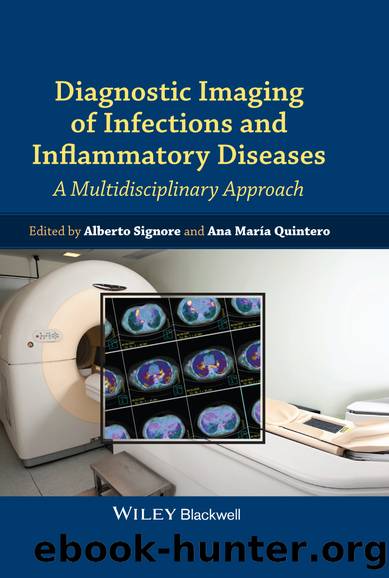Diagnostic Imaging of Infections and Inflammatory Diseases by Signore Alberto;Quintero Ana Maria; & Ana María Quintero

Author:Signore, Alberto;Quintero, Ana Maria; & Ana María Quintero
Language: eng
Format: epub
Publisher: John Wiley & Sons, Incorporated
Published: 2013-06-20T00:00:00+00:00
Sternal wound infections
Median sternotomy wound complications vary from sterile wound dehiscence to suppurative mediastinitis. Mediastinal, or sternal, wound infections are characterized by clinical or microbiological evidence of infected presternal tissue and sternal osteomyelitis, with or without mediastinal sepsis and with or without unstable sternum. Superficial sternal wound infection is confined to the subcutaneous tissue. Deep wound infection, or mediastinitis, is associated with sternal osteomyelitis with or without retrosternal space infection [79].
Although the incidence of sternal wound infection in patients undergoing median sternotomy is less than 1%, its associated mortality rate varies from 14% to 47%. The classic symptoms and signs of acute infection are infrequently encountered and can be obscured by associated postoperative pain or concomitant infection. Wound discharge, the most common presentation, is present in up to 70â90% of cases; local symptoms include wound pain, tenderness and sternal instability. Daily clinical evaluation of patients in the immediate postoperative period and a high index of suspicion are the most important factors in ensuring early diagnosis. Blood cultures should be performed in patients with a temperature above 38 °C that persists for more than 48 hours after surgery. Chest radiographs rarely are helpful. CT with mediastinal aspiration provides useful information both for diagnosis and management [79].
Radionuclide imaging also contributes useful information in patients with suspected sternal wound infection [80â86]. Cooper et al. [82] studied 99mTc-labeled WBC imaging in 29 patients with suspected sternal wound infections. They found that the test was 100% sensitive and 89% specific for diagnosing deep sternal wound infection, and suggested that labeled WBC imaging is a useful adjunct when clinical examination fails to confirm the diagnosis or when deep sternal aspirates of a sternal wound infection are not diagnostic. Bessette et al. [83] compared CT and dual-isotope SPECT (99mTc-MDP/111In-labeled WBC) in 32 patients with possible postoperative sternal osteomyelitis following median sternotomy. These authors found that the radionuclide test was more accurate than CT for differentiating soft tissue inflammation from sternal osteomyelitis.
Quirce et al. [84] prospectively investigated planar scintigraphy and 99mTc-labeled WBC SPECT in 41 patients with clinically suspected deep sternal infection. Nine patients had deep sternal infection, ten had superficial sternal infection and 22 had no infection. Planar imaging failed to detect any of the deep sternal infections at either 4 or 20 hours. SPECT correctly identified eight of nine deep sternal infections at 4 hours and all of them at 20 hours, with no false-positive results. Planar imaging identified 16 of 18 superficial sternal infections at 4 hours and all of them at 20 hours. SPECT identified 17 of 18 infections at 4 hours and all of them at 20 hours. Other infections unrelated to the sternotomy were identified in seven patients. The authors concluded that labeled WBC imaging reliably diagnoses sternal infection after median sternotomy and SPECT facilitates the differentiation of superficial from deep sternal infection. The test also detects other sites of infection, providing alternative diagnoses.
Bitkover et al. [85] investigated the anti-G mAb, BW 250/183, for diagnosing sternal infection in 29 patients who had
Download
This site does not store any files on its server. We only index and link to content provided by other sites. Please contact the content providers to delete copyright contents if any and email us, we'll remove relevant links or contents immediately.
| Administration & Medicine Economics | Allied Health Professions |
| Basic Sciences | Dentistry |
| History | Medical Informatics |
| Medicine | Nursing |
| Pharmacology | Psychology |
| Research | Veterinary Medicine |
Periodization Training for Sports by Tudor Bompa(7749)
Why We Sleep: Unlocking the Power of Sleep and Dreams by Matthew Walker(6163)
Paper Towns by Green John(4626)
The Immortal Life of Henrietta Lacks by Rebecca Skloot(4112)
The Sports Rules Book by Human Kinetics(3928)
Dynamic Alignment Through Imagery by Eric Franklin(3766)
ACSM's Complete Guide to Fitness & Health by ACSM(3693)
Kaplan MCAT Organic Chemistry Review: Created for MCAT 2015 (Kaplan Test Prep) by Kaplan(3657)
Introduction to Kinesiology by Shirl J. Hoffman(3497)
Livewired by David Eagleman(3406)
The River of Consciousness by Oliver Sacks(3275)
The Death of the Heart by Elizabeth Bowen(3191)
Alchemy and Alchemists by C. J. S. Thompson(3162)
Descartes' Error by Antonio Damasio(3038)
Bad Pharma by Ben Goldacre(2963)
The Gene: An Intimate History by Siddhartha Mukherjee(2773)
The Emperor of All Maladies: A Biography of Cancer by Siddhartha Mukherjee(2752)
The Fate of Rome: Climate, Disease, and the End of an Empire (The Princeton History of the Ancient World) by Kyle Harper(2703)
Kaplan MCAT Behavioral Sciences Review: Created for MCAT 2015 (Kaplan Test Prep) by Kaplan(2673)
